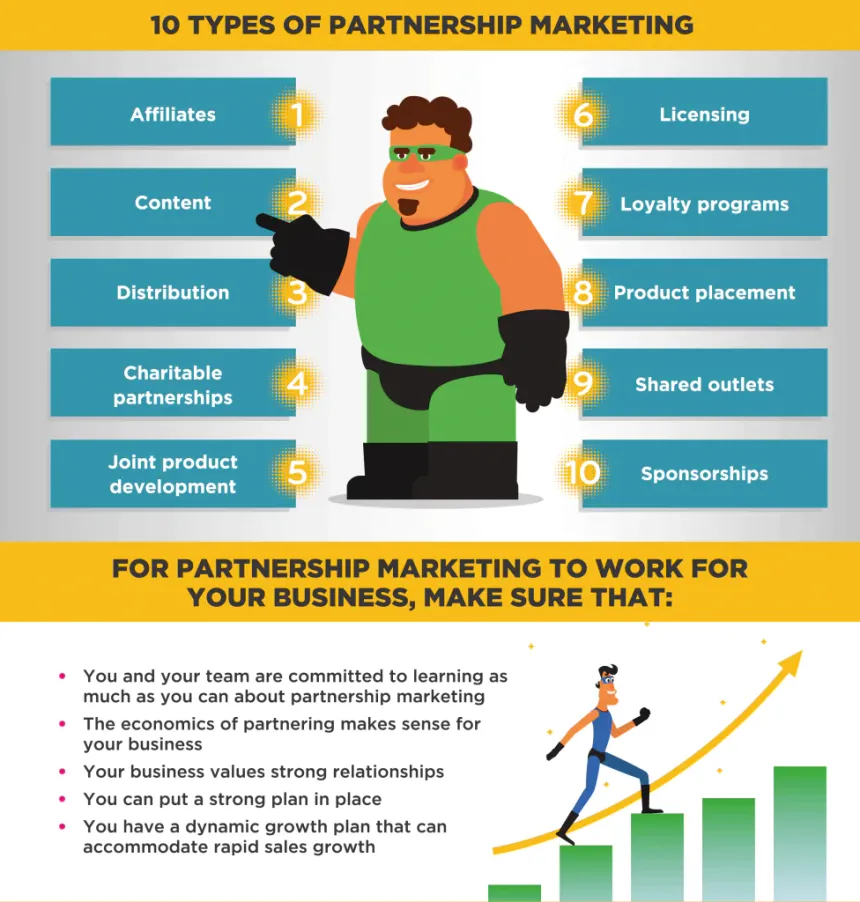Table of Contents
In the business world, understanding how to use the right media partner to sell your product can be likened to selecting the perfect puzzle piece to complete a masterpiece. Your media partners are press outfits or outlets that you work with to foster your brand’s marketing strategy, helping your product shine brightly.
If you are conversant with the news, you will remember Rema’s viral statement during his acceptance speech at the 16th Headies Awards on Sunday, September 4th. His memorable statement serves as a powerful reminder of the media’s influence as a juggernaut that propels not just individuals but businesses to success.

Just as Rema and his peers have expertly solved the puzzle of success with media, you will embark on a journey to unveil the secrets of finding that crucial piece to complete your brand’s publicity. In this article, you will be walked through the qualities of a media partner, their merits, and the steps to approach a suitable partner, leaving you with one or two fortune cookies.
10 Qualities to Look Out for in a Media Partner
Your media partner is a media outlet that collaborates with your company or organisation to achieve mutually beneficial goals. The partnership is formed to leverage the strengths and resources of each party to achieve common goals related to marketing and promotion.
If a media outlet checks at least seven of these attribute checkboxes, utilising their outlets to sell your product is safe.
- Relevant Audience: Ensure that your target audience demographics are in alignment with your prospective media partner’s audience.
- Reputation: Investigate the reputation of your prospective partner. Aligning yourself with a trusted media outlet can enhance your brand’s credibility.
- Experience: Look for a media partner with a successful track record within your niche or industry. Experience can yield more effective and efficient results.
- Audience Reach: Evaluate the leads of your prospective partner, both in terms of audience size and geographic coverage. A great partner should contribute towards increasing your reach.
- Content Quality: Review the quality and relevance of the content they produce. Highly engaging content that resonates with your brand’s values can be more effective.
- Engagement Metrics: Assess their ability to engage with their audience through comments, shares, likes, and click-through rates. This is likely to determine their active followers.
- Social Media Presence: Active partners on multiple social media platforms are recommended for maximum exposure.
- Cost and Return on Investment (ROI): Evaluate and juxtapose the cost of the partnership with the potential return on investment projection for your brand.
- Alignment with Brand Values: It is necessary to form partnerships with media outlets that align with your company’s values, mission, and vision.
- Innovation: Check if your potential partner is susceptible to new ideas and technologies to make the brand’s strategies effective.
5 Steps to Approach a Media Partner

Before you approach a prospective media partner, you need to have a clear vision of your aims, the method of measuring your achievement (KPIs), and the resources you have at your disposal. Let the culmination of these revolve around being SMART. Scientific, Measurable, Achievable, Realistic, and Time-bound.
Let us discuss five practical processes involved in meeting a suitable media partner.
- Research and Target: Conduct a background study on various media outlets based on the identified qualities. Make relevance to the target audience, your niche, your values, and your goals your top priority on the checklist. This is where you decide which company is suitable for what purpose.
- Curate your List: Using the knowledge of a suitable media partner, make a long list of prospective media partners with their contact information and possibly each of their unique selling points. This will aid decision-making in terms of a preference scale.
- Conduct a Scale of Preference: Narrow down your list to contain fewer people arranged on a scale of how much you want them to work with to the least company you want to work with.
- Draft a Compelling Proposal: Craft a persuasive pitch that encompasses what your brand is about and the benefits of partnering with it. Be careful of your diction, and clearly articulate your offer, your expectations, and how it aligns with the organisational goal.
- Establish a Professional Connection: Initiate a genuine but professional connection with your identified partner(s). Such connections can be made through a phone call, a message on LinkedIn, or a well-written email. It has to be straightforward and well articulated to express your interest or proposal.
7 Benefits of a Media Partner to Sell Your Product
Think about media partnerships in the light of friendship. Your friend is a person with whom you share a bond of mutual affection. Your media partners are also your buddies who have your back when you need help. They not only assist in times of need, but they also come in handy for:
- Shared Goals: Media partnerships are formed to achieve SMART objectives like increasing a brand’s visibility, reaching a broader audience, product promotion, or even content creation. Whichever goal is set usually aligns with both parties’ values.
- Extended Audience: Media partnerships allow brands to tap into the established audience, rich backlinks, and distribution channels of the media outlet. This leads to increased visibility, expanded reach, and access to broader demographics.
- Enhanced Credibility: associating with a respected media outlet enhances the credibility of a brand or company. An endorsement from a trusted source can trigger the confidence of the target audience.
- Cost-Effective Marketing and Promotion: Partnering with media outlets often provides cost-effective marketing plans. This is particularly beneficial for small businesses with limited marketing budgets.
- Experience and Insight: Expertise in content creation, marketing, and audience engagement is a defined feature of media outlets. Brainstorming with them provides a free ride to learning from their ocean of knowledge and industry trends, which can come in handy for marketing strategy optimisation.
- Checks and Balances: Media partnership is like having an accountability partner who is in charge of monitoring and evaluation. The media outlets use Key Point Indicators (KPIs) to measure the effectiveness and efficiency of utilising their medium to achieve a set of goals
- Mutual Benefit: Both organisations benefit from the collaboration. The businesses gain access to the media outlet’s audience, while the media outlets benefit from content, advertising revenue, or an increased engagement rate. The partnership can take different forms. It can be:
- Content partnerships: Collaborating on articles, videos, or events.
- Advertising partnerships: Running adverts or sponsored content.
- Event partnerships: co-hosting or promoting events, to mention but a few.
How to Write a Media Partnership Proposal Letter

The proposal is an integral part of the media partnership as it contains the essence of the deal. It answers the 5 W’s and H regarding the partnership deal. A standard media proposal needs to consist of:
- Letterhead: Also known as a header. It should contain the organization’s name, address, phone number, email, and the date.
- Salutation: If possible, The proposal must be addressed to the appropriate person. Use “Dear Receiver’s Name” for this.
- Introduction: Begin the letter with a brief and engaging introduction. Mention who you are and your organisation. Clearly state your purpose for writing the letter, which is to propose a media partnership.
- Body: The body captures the main essence of the letter. In the body, one has to:
- Highlight and explain the benefits of the partnership for both parties.
- Describe your organization’s background, mission, and goals. Discuss how it aligns with the media outlets.
- Clearly outline the scope of the partnership, including the duration, responsibility, and any financial aspects. Articulate what you expect from the other party, such as promotional support, collaborative efforts, and your willingness to offer.
- Benefits for the Other Party: Emphasise what’s in it for the recipient or their organisation. Explain how the partnership can help them achieve their goals.
- Present any relevant data or statistics to support your proposal.
- Mention any previous successful partnerships or collaborations your organization has had.
- Discuss the target audience and how the partnership can help reach a broader audience or engage a specific demographic.
- Call to Action: Clearly state what you want the recipient to do next. This could be scheduling a meeting and discussing the proposal.
- Closing: Thank the recipient for considering your proposal. Use closings such as ” Yours Sincerely” or “Best regards.”
- Signature: Append your signature above your typed name, and include your title and organization.
- Attachments: If you have any supporting documents or media files, attach them to the letter.
- Follow-Up: Follow up with the recipient after a reasonable amount of time to discuss the proposal further or address any questions they may have.
Remember to tailor the proposal to the specific needs and interests of the potential partner and proofread the letter carefully before sending it. A well-crafted media partnership proposal can be a catapult for building valuable collaborations.
What Do You Offer to Your Media Partner?

Remember when you were promised a fortune cookie at the beginning of this article? Congratulations on making it this far!
In a media partnership, it is paramount that a mutually beneficial exchange occur. As such, your company or brand can make various offers to your prospective partners. Some of them include:
- Content Generation: You can offer to generate high-quality written content, including articles, blog posts, social media posts, and more, to ease their workload.
- Availability: You can offer to be available around the clock, allowing for the “time-bound” aspect of the SMART plan.
- Data Insights: You can offer valuable data and analytics insights to help them better understand their audience. Sharing your audience demographics, engagement metrics, and trends can better enhance their understanding of what you want and how to achieve it.
- Shout Out and Mentions: You can offer to mention them in your welcome address at an event or shout out on a social media post.
- Promotion: Propose promotional opportunities as well. Special features of their logo on your banners or website can go a long way in fostering a symbiotic relationship.
Conclusion
In everything you do, it is essential to always keep in mind that media partnership is a two-way street. You must mutually benefit each other in a partnership deal; otherwise, it is unfair.
Always remember to ask yourself what you bring to the table as a brand, company, or organization, then utilize it to find the right media partner to sell your products.
Frequently Asked Questions
What is a media partnership?
Media partnership is a collaboration between two or more parties. The parties can be media outfits or a combination of brand/company with a media outlet to work together to achieve a common goal related to content creation, dissemination, and promotion.
What is an example of a media partnership?
A typical example of a media partnership is a brand and media outlet collaboration. The brand may partner with a media outlet like a newspaper, radio, television channels, or even an online publication to create and distribute content for such a brand. When generated and distributed, such content aims to accomplish goals set to be achieved at the end of the media partnership.
What is the best platform for media sharing?
There is no straight answer to this question. The platforms to utilize depend on your brand’s specific marketing needs and preferences. To select the best platform, you need to look at the target audience, the type of media you want to share, and your privacy preferences. Each platform has its strengths and limitations.
What does social selling mean?
Social selling is a sales strategy using social media platforms to connect with potential customers, build relationships, and drive sales by nurturing leads and producing content. The two parties involved in social selling are sales professionals and potential customers.

